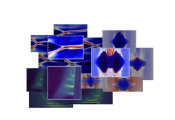Understanding Order to Disorder at the Atomic Scale Opens Possibilities for Next-Generation Electronic Devices
September 08, 2025 -- Two decades ago, scientists peeled away layers from graphite, the soft carbon in pencil tips, to isolate a single atomic sheet known as graphene—the first human-synthesized two-dimensional (2D) material. Its discovery heralded new technologies: flexible displays, faster computer chips, and high-capacity batteries.
But graphene is made entirely of carbon, which limits scientists’ ability to fine-tune its properties for new functions. A “gold rush-like” search for other alternatives ensued, producing boron nitride, dichalcogenides like molybdenum sulfide, and the largest family of all, MXenes, says Aleksandra Vojvodic, professor in the Department of Chemical and Biomolecular Engineering in Penn’s School of Engineering and Applied Science.
The 2D MXenes consist of sheets of carbon or nitrogen sandwiched between sheets of transition metals like titanium, vanadium, and molybdenum, resulting in thin materials that are typically three, five, or seven atomic layers. So far, MXenes uses have generally been limited to just one or two transition metal types—owing to inherent chemical and thermodynamic constraints related to combining many more metals.
“While these 2D materials hold a great promise for next-generation applications, for example, consumer electronics, medical devices, energy storage and conversion, the exact material synthesis recipes on where and how to position the atoms within the sheets are extremely limited and mostly unknown,” Vojvodic says.
Now, Vojvodic, along with Penn’s Zahra Fakhraai, and collaborators at the MXenes Synthesis, Tunability and Reactivity (M-STAR) Center for Chemical Innovation (CCI, supported by National Science Foundation), have found a way add up to nine metals into the mix. Their findings speak to a longstanding issue multi-metal materials: does atomic order (enthalpy) or disorder (entropy) ultimately dictate the synthesis and behavior of these materials? Put another way, they showed that in the world of MXenes, chaos can be constructive. Sometimes adding more elements, makes it is easier to manipulate the system for greater versatility.
“This discovery shows how chemistry and geometry interplay to dictate order or disorder, offering new pathways for designing MXenes with precisely controlled properties for diverse applications,” says Fakhraai, a professor in the Department of Chemistry. “Now you can choose anywhere from one up to nine metals to be incorporated into unique 2D MXene materials with different degrees of structural ordering offering potentially new properties.”
Their findings are published in Science.




































